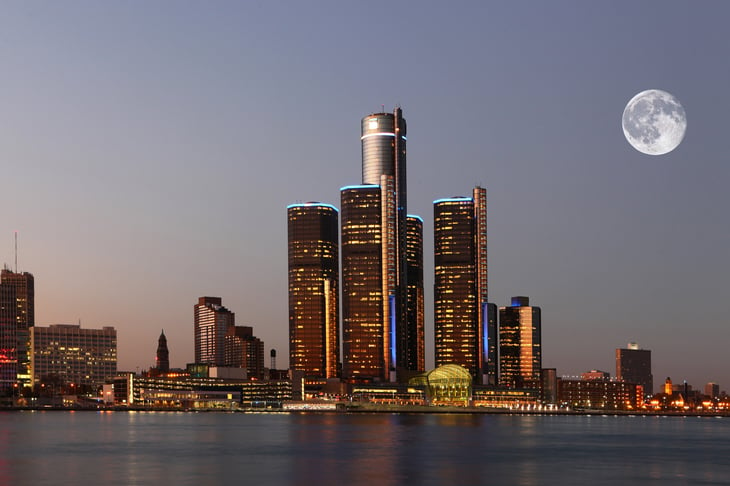
This story originally appeared on CoPilot.
Nearly one year into the COVID-19 pandemic, the used car market continues to shift and recover in response to changes in driving preferences and disruptions to the global supply chain brought in 2020.
On the supply side, one of the major challenges for the car market in general has been the fact that manufacturers produced fewer new vehicles in the first half of 2020. As many parts of the world shut down in an effort to slow the spread of the virus, car factories were not able to produce new vehicles at their usual rate. This constraint on supply has raised prices in the used car market as car buyers face limited options.
Despite increased car prices, the supply of used cars is also higher than it was a year ago by the measure of market days supply, or the number of days it would take to run out of dealer inventory at the current level of demand. One reason for this is that when the pandemic first hit, manufacturers delayed lease returns by incentivizing extensions. Those gently used, highly optioned, low-mileage cars are now coming back into the market, helping to fill up dealer lots. Under normal conditions, this influx of near-new supply would lead to lower prices for consumers, but the reduced availability of new vehicles has more consumers open to the idea of a used car. With more buyers in the market, prices for used vehicles have remained high.
By the measure of market days supply, spring and early summer 2020 represented a major aberration. Market days supply spiked to 71 days in April when most stay-at-home orders were in place. When states began to reopen in the late spring and early summer, vehicles moved more quickly, pushing market days supply down to 30 by July. Since then, the supply of used cars has rebounded on this measure and leveled out at around 45 days, just above the 42 days from a year ago and the 40 days considered healthy for the market.
On the demand side, the pandemic’s disruptions may have also affected the types of vehicles that are moving on the used car market. Commuter-oriented vehicles like sedans and hatchbacks have seen their supply increase by more than 20 percent year-over-year as people continue to work from home. At the other end of the spectrum, market days supply for trucks and SUVs are flat compared to 2019, while vans and cargo vans are actually in lower supply than a year ago. These vehicle segments are more likely to be used by people or companies whose work has continued in-person in the wake of COVID-19, like building trades or logistics.
The Best Metros to Buy a Used Car

Market patterns vary by location, so some states have a much higher supply than others. Most of the states with the highest inventory are rural Northern states, led by Alaska at 80 market days supply, Vermont at 71, and South Dakota at 67. The states where vehicles are in lowest supply are Nevada at 37 days; Florida, Tennessee, and Maryland at 38; and Texas at 39.
To identify the state and local markets best for buying a used car, researchers used CoPilot’s proprietary dataset of more than 1.3 million used car listings in the U.S. Researchers calculated market days supply for each location and ranked them, assuming that locations with high supply are good for buyers and those with low supply are good for sellers. The research team additionally calculated year-over-year change in supply for each vehicle segment in these locations to determine the best segments for buyers (where supply is up) and sellers (where supply is down or increasingly slower).
Keep reading for the best U.S. metropolitan areas to buy a used car.
15. Philadelphia-Camden-Wilmington, PA-NJ-DE-MD

- Market days supply: 52
- Average used car price: $22,573
- Best segment for buyers: Minivan
- Best segment for sellers: Van
14. Kansas City, MO-KS

- Market days supply: 52
- Average used car price: $22,507
- Best segment for buyers: Wagon
- Best segment for sellers: SUV
13. Grand Rapids-Wyoming, MI

- Market days supply: 52
- Average used car price: $22,166
- Best segment for buyers: Convertible
- Best segment for sellers: Wagon
12. Detroit-Warren-Dearborn, MI

- Market days supply: 52
- Average used car price: $22,120
- Best segment for buyers: Hatchback
- Best segment for sellers: Cargo van
11. Cleveland-Elyria, OH

- Market days supply: 53
- Average used car price: $21,154
- Best segment for buyers: Van
- Best segment for sellers: Cargo van
10. Chicago-Naperville-Elgin, IL-IN-WI

- Market days supply: 54
- Average used car price: $23,349
- Best segment for buyers: Coupe
- Best segment for sellers: Van
9. Minneapolis-St. Paul-Bloomington, MN-WI

- Market days supply: 54
- Average used car price: $22,986
- Best segment for buyers: Van
- Best segment for sellers: Cargo van
8. Milwaukee-Waukesha-West Allis, WI

- Market days supply: 55
- Average used car price: $23,743
- Best segment for buyers: Coupe
- Best segment for sellers: Cargo van
7. Boston-Cambridge-Newton, MA-NH

- Market days supply: 55
- Average used car price: $23,402
- Best segment for buyers: Minivan
- Best segment for sellers: Van
6. New York-Newark-Jersey City, NY-NJ-PA

- Market days supply: 55
- Average used car price: $23,048
- Best segment for buyers: Hatchback
- Best segment for sellers: Van
5. Pittsburgh, PA

- Market days supply: 56
- Average used car price: $21,813
- Best segment for buyers: Sedan
- Best segment for sellers: Cargo van
4. Providence-Warwick, RI-MA

- Market days supply: 57
- Average used car price: $23,233
- Best segment for buyers: Minivan
- Best segment for sellers: Van
3. Hartford-West Hartford-East Hartford, CT

- Market days supply: 58
- Average used car price: $23,411
- Best segment for buyers: Minivan
- Best segment for sellers: Convertible
2. Buffalo-Cheektowaga-Niagara Falls, NY

- Market days supply: 61
- Average used car price: $24,339
- Best segment for buyers: Hatchback
- Best segment for sellers: Wagon
1. Rochester, NY

- Market days supply: 63
- Average used car price: $24,201
- Best segment for buyers: Sedan
- Best segment for sellers: Convertible
Methodology & Detailed Findings

The data used in this analysis is from CoPilot’s proprietary dataset of more than 1.3 million used car listings in the United States. To identify the best locations to buy a used car, researchers calculated the market days supply for each location, which is an expression of how many days it would take to run out of dealer inventory at the current level of demand. Locations with high levels of supply are good for buyers; whereas, locations with low supply are good for sellers. Locations were ordered based on their respective market days supply as of January 2021. In the event of a tie, the location with the lower average used car price was ranked as better for buyers.
To identify the best segments for buyers and sellers, researchers calculated the year-over-year change in market days supply for each segment in each location. Vehicle segments with the largest increase in supply were listed as the best for buyers in that location; whereas, those with the biggest decrease in supply (or in some cases, the smallest increase in supply) were listed as the best for sellers. Exotic vehicles and segments with too few listings for specific geographies were not included in the segment analysis.
Only metropolitan areas with at least 1 million residents were included in the analysis.






Add a Comment
Our Policy: We welcome relevant and respectful comments in order to foster healthy and informative discussions. All other comments may be removed. Comments with links are automatically held for moderation.